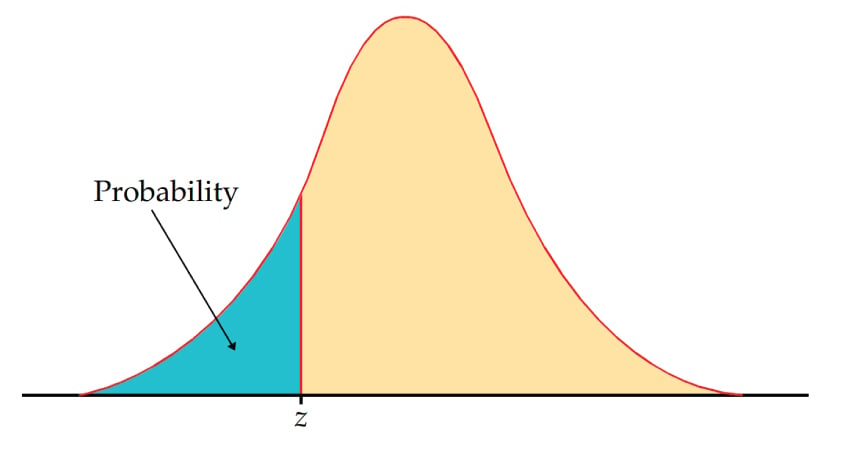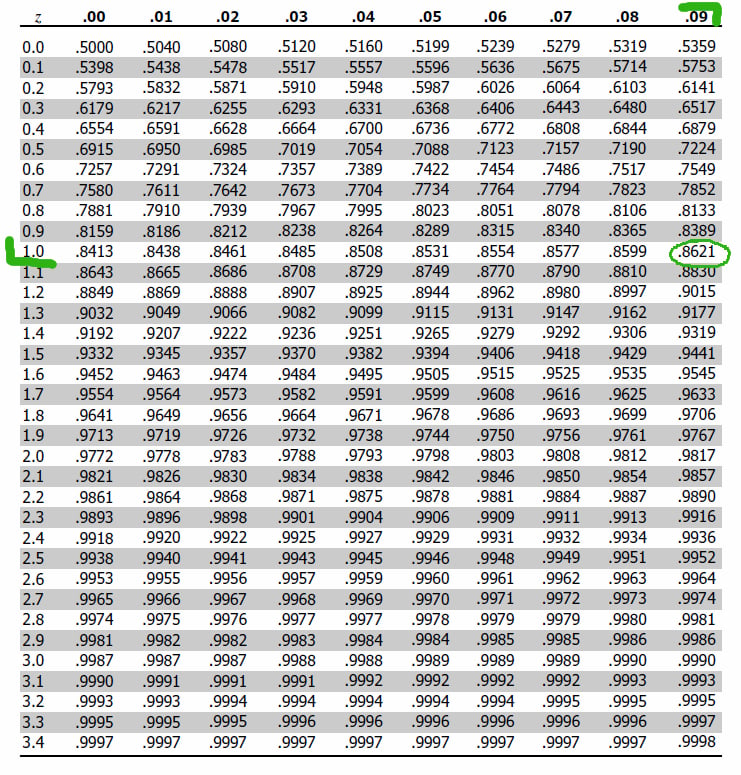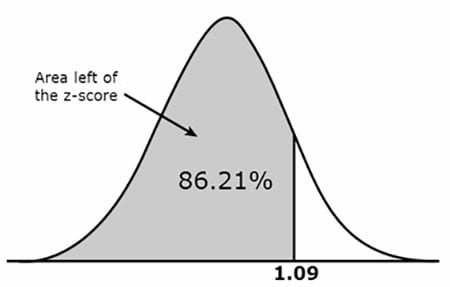A Z-score table, also called the standard normal table, or z-score chart, is a mathematical table that allows us to know the percentage of values below (usually a decimal figure) to the left of a given Z-score on a standard normal distribution (SND).

There are two z-score tables which are:
-
Positive Z-score Table: Used when the Z-score is positive and above the mean. A positive Z-score table allows you to find the percentage or probability of all values occurring below a given positive Z-score in a standard normal distribution.
-
Negative Z-score Table: Used when the Z-score is negative and below the mean. A negative Z-score table allows you to find the percentage or probability of all values occurring below a given negative Z-score in a standard normal distribution.
Each type of table typically includes values for both the whole number and tenth place of the Z-score in the rows (e.g., -3.3, -3.2, …, 3.2, 3.3) and for the hundredth place in the columns (e.g., 0.00, 0.01, …, 0.09).
A Z-score table can be used to determine if a score is statistically significant by providing a way to find the p-value associated with a given Z-score.
The p-value is the probability of obtaining a result at least as extreme as the one observed, assuming the null hypothesis is true.
How To Read Z-Score Table
Reading a Z-score table might initially seem tricky, but it becomes pretty straightforward once you understand the layout.
There are two kinds of Z-tables: for “less than” probabilities and for “more than” probabilities. The “less than” table is the most commonly used one.
A Z-score table shows the percentage of values (usually a decimal figure) to the left of a given Z-score on a standard normal distribution.
Here’s how you can read it:
-
Look at the Z-table. The left column will contain the first part of the Z-score (e.g., the whole number and the first digit after the decimal point). Go down this column until you find your Z-score’s first part.
-
Next, look at the top row of the Z-table. This row will contain the second part of the Z-score (the remaining decimal number). Go across this row until you find your Z-score’s second part.
-
The intersection of the row from the first part and the column from the second part will give you the value associated with your Z-score. This value represents the proportion of the data set that lies below the value corresponding to your Z-score in a standard normal distribution.
For example, imagine our Z-score value is 1.09.
First, look at the left side column of the z-table to find the value corresponding to one decimal place of the z-score. In this case, it is 1.0.
Then, we look up the remaining number across the table (on the top), which is 0.09 in our example.

The corresponding area is 0.8621, which translates into 86.21% of the standard normal distribution being below (or to the left) of the z-score.

To find the p-value, subtract this from 1 (which gives you 0.1379), then multiply by 2 (which gives you p = 0.2758).
The results are not statistically significant because the p-value is greater than the predetermined significance level (p = 0.05), and the null hypothesis is accepted.
Right of a positive z-score
To find the area to the right of a positive z-score, begin by reading off the area in the standard normal distribution table.
Since the total area under the bell curve is 1 (as a decimal value equivalent to 100%), we subtract the area from the table from 1.
For example, the area to the left of z = 1.09 is given in the table as .8621. Thus the area to the right of z = 1.09 is 1 – .8621. = .1379.
Left of a negative z-score
If you have a negative z-score, use the same table but disregard the negative sign, then subtract the area from the table from 1.
Right of a negative z-score
If you have a negative z-score, use the same table but disregard the negative sign to find the area above your z-score.
Finding the area between two z-scores
To find the area between two negative z-scores, we must first find the area (proportion of the SND) to the left of the lowest z-score value and the area (proportion of the SND) to the right of the highest z-score value.
Next, we must add these proportional values and subtract them from 1 (the SND’s total area of the SND.

